
Direct vs indirect characterization: How to show and tell
There are two main ways to reveal characters: direct characterization, and indirect characterization. What defines these two characterization types, and what are the strengths and weaknesses of each?
- Post author By Jordan
- 26 Comments on Direct vs indirect characterization: How to show and tell

Characterization describes the way a writer or actor creates or implies a character’s personality, their inner life and psyche. Two main ways to reveal your characters are direct characterization and indirect characterization. What are these character creation techniques? Read on for examples of characterization that illustrate both:
Guide to direct and indirect characterization: Contents
What is direct characterization, direct characterization example, what is indirect characterization, indirect characterization example.
- Eight tips for using direct vs indirect characterization
Let’s delve into using both characterization devices:
To begin with a definition of direct characterization, this means the author explicitly tells the reader a character’s personality .
For example, explicitly telling the reader a character is kind, funny, eccentric, and so forth.
Here’s an example of direct characterization from Virginia Woolf’s To the Lighthouse (1925).
Woolf explicitly shows what characters think of one another . In the example, an artist staying with the Ramsay family, Lily Briscoe, thinks about Mr Ramsay whom a man Mr Bankes has just called a hypocrite:
Looking up, there he was – Mr. Ramsay – advancing towards them, swinging, careless, oblivious, remote. A bit of a hypocrite? she repeated. Oh no – the most sincere of men, the truest (here he was), the best; but, looking down, she thought, he is absorbed in himself, he is tyrannical, he is unjust… Virginia Woolf, To The Lighthouse (1927), p. 52.
This is direct characterization – through Lily, Woolf describes Mr. Ramsay’s traits directly.
It’s telling (direct characterization typically is), but because we read it as one character’s opinion of another, it also shows us how Lily feels, whether or not she agrees with the statement that Mr. Ramsay is a hypocrite.
Through Lily, we learn Ramsay is ‘absorbed in himself’ or self-absorbed, tyrannical – we read direct statements about Ramsay’s personality that help us picture him and how he comes across to others.
‘Indirect characterization’ shows readers your characters’ traits without explicitly describing them.
To give simpler examples of direct vs indirect characterization, for direct you might write, ‘Jessica was a goofy, eccentric teacher’.
For indirect revelation of Jessica’s character, you might write instead, ‘Jessica had named the stick with a hook on the end she used to open the classroom’s high windows Belinda and would regale her children with stories of Belinda’s adventures (even though they were fourteen, not four)’.
In the second example of characterization above (the indirect kind), it is inferred that Jessica is goofy and eccentric. She names inanimate objects and tells teenagers stories of make-believe that would probably be better-suited to younger children.
Indirect characterization invites your reader to deduce things about your characters, without explicitly telling them who they are.
Here, John Steinbeck in The Grapes of Wrath (1939) shows a character’s personality indirectly.
Steinbeck doesn’t say that hitchhiker Joad is a down-and-out, blue-collar worker. Instead, the author creates indirect characterization through the items a worker in this context would perhaps have: whiskey, cigarettes, calloused hands:
Joad took a quick drink from the flask. He dragged the last smoke from his raveling cigarette and then, with callused thumb and forefinger, crushed out the glowing end. He rubbed the butt to a pulp and put it out the window, letting the breeze suck it from his fingers. John Steinbeck, The Grapes of Wrath (1939), p. 9.
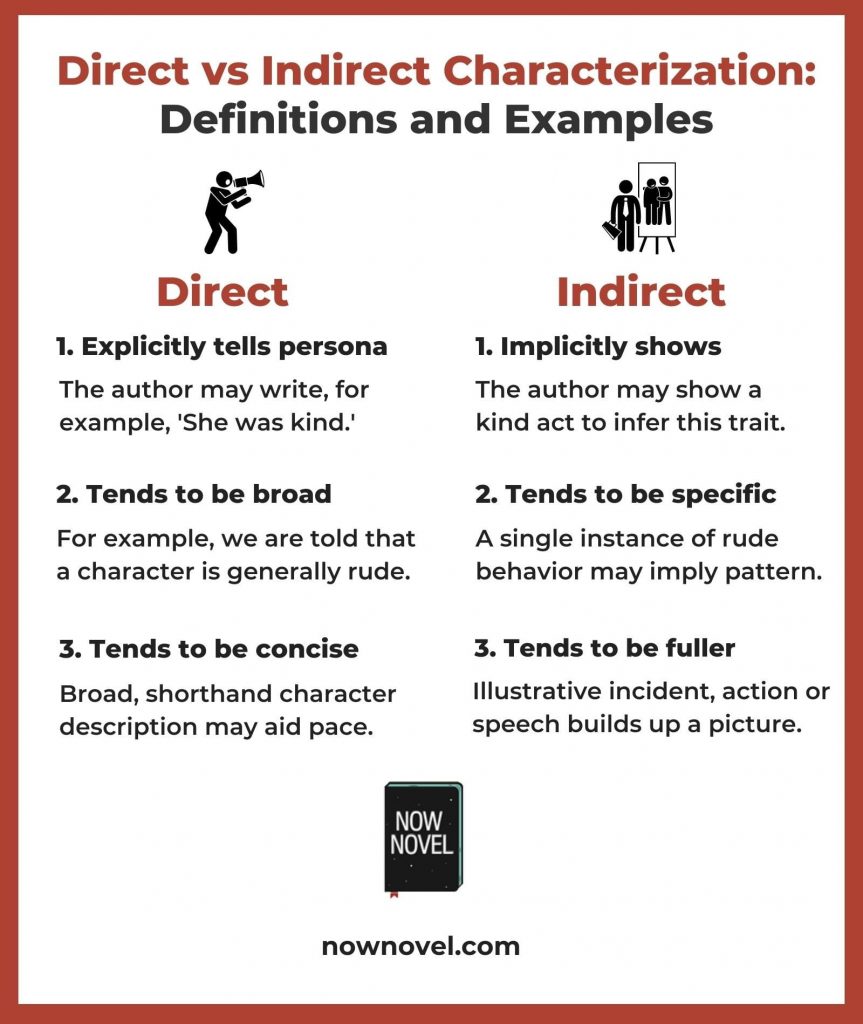
Types of indirect characterization
What types of indirect characterization are there?
Any writing that helps us infer or deduce things about a person’s psyche, emotions, values or mannerisms. For example:
- Dialogue-based inference: From the way your character speaks to others in the story, your reader may deduce that they are kind, cruel, gentle, etc.
- Implying through action: What your character does (for example jumping on a beetle to squash it) implies their character (in this case, it may imply that a character is cruel).
- Fly-on-wall description: Although what visual description implies may differ from country to country, culture to culture, neutrally-worded description may cause your reader to make specific assumptions based on what you’ve shown. We might assume, for example, an extremely pale-skinned character is reclusive or agoraphobic, like the reclusive Boo Radley in Harper Lee’s To Kill a Mockingbird .
So how do you use direct and indirect characterization well? Read tips for each (and our complete guide to description for more examples):
8 tips for using direct and indirect characterization
Avoid overusing direct characterization, be direct with key details, support direct character statements with scenes, imply character through action and reaction, tell direct details that serve concision, use dialogue to characterize indirectly, let narrative voice give character, read examples of direct and indirect characterization.
Direct characterization is useful shorthand. Instead of pages showing how a character is mean, you could start with ‘He was mean.’ Balance is key, though. Overusing direct characterizing may skew the balance towards telling, not showing. Tweet This
If, for example, you wrote, ‘He was mean. He was petty and generally unkind, so that neighbors crossed the street when he passed,’ that mixes some indirect characterization with the direct type. Neighbors crossing the street is a visual that indirectly implies avoidance and discomfort or possible dislike.
If you were to only tell readers about your characters’ traits without weaving in illustrative showing (which give indirect inference about who your characters are), the effect would be:
- Hazy visuals : Crossing the street in the example above gives a more specific visual than simply saying ‘he was disliked by the community’.
- Lack of depth and color: If you tell your reader who your characters are exclusively with minimal showing or inferring, it may read as though you have a private understanding of your characters you are summarizing for the reader, rather than showing them a fuller, more detailed picture.
Make a Strong Start to your Book
Join Kickstart your Novel and get professional feedback on your first three chapters and story synopsis, plus workbooks and videos.

Example of blending direct and indirect character detail
The opening of Toni Morrison’s powerful novel Beloved characterizes a house that is haunted by the ghost of an infant.
Note how Morrison moves from the direct characterization of the first sentence to specific, visual details:
124 was spiteful. Full of a baby’s venom. The women in the house knew it and so did the children. For years each put up with the spite in his own way, but by 1873 Sethe and her daughter Denver were its only victims. The grandmother, Baby Suggs, was dead, and the sons, Howard and Buglar, had run away by the time they were thirteen years old – as soon as merely looking in a mirror shattered it (that was the signal for Buglar); as soon as two tiny hand prints appeared in the cake (that was it for Howard). Toni Morrison, Beloved (1987), p. 17.
The trick to effective direct characterization is to reserve it for key details you want to establish upfront.
In the example of blending indirect and direct character description above, Morrison starts with direct, broad detail. A sense of spite that drives boys in the family from a home filled with the ghosts of a corrosive, violent history.
If you were to write a retelling of Charles Dickens’ A Christmas Carol you might start with ‘Scrooge was stingy’ and then similar flesh this key detail out with the illustrative, supporting detail.
The indirect characterization you then add on to key details gives further texture, color, specificity to your characters. It helps, of course, to know your characters inside out:
The example above from Beloved shows how indirect characterization supports direct descriptive statements .
The boys Howard and Buglar fleeing from mirrors that seem to shatter by themselves or tiny hand prints appearing in a cake, for example. These specific images and incidents support the suggestion that the home at 124 is haunted by a ‘spiteful’ (or rather, determined-to-be-known) presence.
If you tell your reader a character is kind, think of dedicated scenes as well as passing moments that support the direct revelation.
Maybe your character gives up a seat on public transport for an elderly person. Maybe they help a neighbor get a pet that has run out of an open gate into a busy road to safety.
Indirect characterization is useful because it shows your reader the type of actions your character is likely to take .
This in turn enables your reader to make educated, qualified guesses about how your characters’ might react in situations whose outcome is not yet known. Through this, one ‘gets to know’ characters as though they were real people.
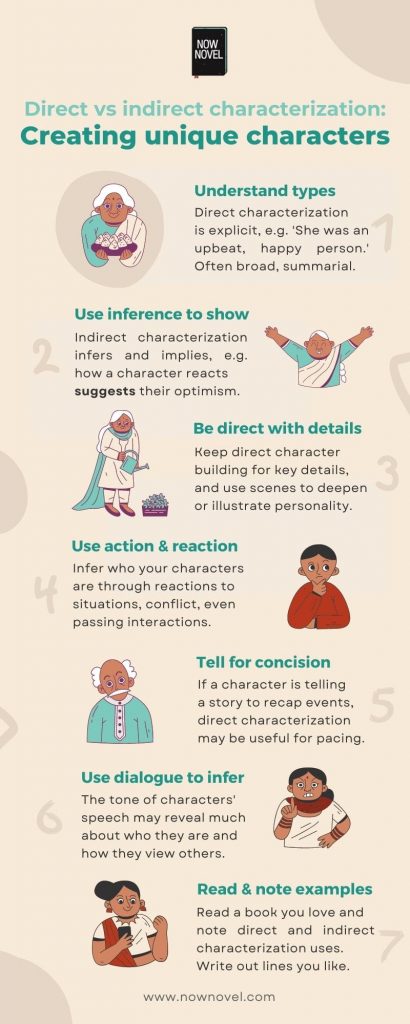
Action and reaction provide useful ways to tell your reader who your characters are indirectly.
For example, Sarah has a vase that belonged to her grandmother that she cherishes, and her hyperactive son knocks it over and breaks it. Does she scold him to be careful? Lash out? Show a mix of anger and understanding?
Think about what you want your reader to infer about a character from the way they react, even in incidents or situations that are trivial or secondary to your story’s main plotline . In this way every scene, every incident, will contribute toward building your characters’ personae.
One of the benefits of direct characterization is that it allows you to be concise.
Direct characterization is useful, for example, when a narrator is recapping prior events that are useful to the present story but not its main focus. For example, in the first page of Nick Hornby’s Slam , a novel about a sixteen-year-old skater named Sam:
So things were ticking along quite nicely. In fact, I’d say that good stuff had been happening pretty solidly for about six months. – For example: Mum got rid of Steve, her rubbish boyfriend. – For example: Mrs Gillet, my art and design teacher, took me to one side after a lesson and asked whether I’d thought of doing art at college. Nick Hornby, Slam (2007), p. 1
At this point in the story, the reader doesn’t need lengthy exposition about why Steve was a rubbish boyfriend. So the direct, telling characterization suits the purpose of this part of the story – catching the reader up on what has been happening in the teenaged protagonist’s life.
There is still balance between indirect and direct characterization in this example. The second example Sam gives tells us (through Mrs Gillet’s action) that the teacher is caring and sees artistic potential in Sam, without saying so explicitly. The part or unique incident suggests the whole of the teacher-student relationship.
Dialogue is a fantastic device for characterization because it may move the story forward while also telling your reader who characters are.
If, for example, there is banter and characters tease each other, it may imply an ease and familiarity (compared to stiff formality between strangers). Note, for example, how Hornby creates a sense of how awkward Rabbit is (an 18-year-old skater at Grind City, a skate park Sam frequents) in the dialogue below:
‘Yo, Sam,’ he said. Did I tell you that my name is sam? Well, now you know. ‘All right?’ ‘How’s it going, man?’ ‘OK.’ ‘Right. Hey, Sam. I know what I was gonna ask you. You know your mum?’ See what I mean about Rabbit being thick? Yes, I told him. I knew my mum. Hornby, pp. 11-12.
In this brief exchange, we see through the awkward, stop-start flow of conversation how Rabbit lacks social graces and awareness and (in the ensuing dialogue) reveals he has a crush on Sam’s mother.
Another useful way to use indirect characterization is to give an involved narrator (a narrator who is also a character in the story) a personality-filled voice .
In the above example of characterization via dialogue, for example, Sam’s asides to the reader (‘Well, now you know’ and ‘See what I mean about Rabbit being thick?’) create the sense of a streetwise, slightly jaded teenaged voice.
Think of ways to inject characters’ personalities into their narration. What subjects do they obsess over (it’s clear Sam loves skating from the first few pages of Slam )? How do they see others (Sam appears fairly dismissive and a little cocky, from referring to his mom’s ‘rubbish’ boyfriend to his blunt description of Rabbit as ‘thick’).
Use language in narration your character would use based on demographic details such as age, cultural background or class identity.
The casual, clipped language Sam uses in the example above suggests the awkward and ‘too cool’ qualities of a teenaged boy.
To really understand the uses of direct and indirect characterization (and how to blend to two to show and tell, describe and imply), look for examples in books.
You could even write out the descriptions you love, to create your own guide to dip into whenever you’re creating characters.
Create believable, developed characters. Finishing a book is easier with structured tools and encouraging support.
Related Posts:
- Indirect characterization: Revealing characters subtly
- Direct characterization: 6 tips for precise description
- Writing advice: Show, don't tell: or should you?
- Tags character description , characterization
Jordan is a writer, editor, community manager and product developer. He received his BA Honours in English Literature and his undergraduate in English Literature and Music from the University of Cape Town.
26 replies on “Direct vs indirect characterization: How to show and tell”
Well explained and helpful
Thank you, Lexi. Thanks for reading!
Thanks for this, I’ve been back a few times now but failed to post a comment. ? This is going to help a lot during this revision!
It’s a pleasure, Robin. Glad you managed in the end. We’ve been migrating our blog to https (more secure) which may have been the cause. Good luck with your revision!
Ah! Okay. Thank you! First books are hard so much to learn. I feel like I could have written two other books while fixings this one. xD (I want to, I enjoy shaping the old chapters to how I write now. ^;^) I also found a program to help speed this up; bibisco. I like it way more than the complicated expensive writing programs out there. IMO.
Where to sign up to get updates for this blog? I don’t want to forget about your blog. (I need reminders for everything. lol. A newsletter is a good way to do that.)
If you sign up for a Now Novel member account, you get subscribed to our blog newsletter too. Alternatively, drop us a line at help at now novel dot com with the email address you’d like to use to get updates and I’ll have our email guy add you to our mailing list. Thanks!
Can you please ,include a section about dynamic and static characters? Thanks for your precious help
Hi Abdou, thank you for the suggestion! I’ll add it to the list for revision ideas, thank you.
You are welcome.
This is such a great website offering very useful tools for writers. I’ve been Googling for days now about everything I wanted to learn in novel writing and I can’t believe I just found this site.
Thanks, Alexa. I’m glad you’ve found our website helpful 🙂
You shared some excellent tips on characterization. I think all writers can benefit from this blog.
Thank you so much, Derrick. I’m glad you’re finding our blog helpful! Thanks for reading.
This is very helpful and I Aced my quiz on something i’m not that good at cool when you lookat the paper it looks long but when you start reading you get lost
Glad you aced your quiz, Kimberly.
Thank You great job!
Thanks, Anna. Thank you for reading our blog!
Very useful.
Thank you so much,
Thank you for your feedback, Aleix. It’s a pleasure, thank you for reading our articles.
Thank you for a clear explanation. It is most useful.
It’s a pleasure, Vivienne. Thank you for reading our blog.
An author employs indirect characterization to avoid explicitly announcing a character’s attributes by revealing those aspects to the reader through the character’s actions, thoughts, and words. Using the phrase “John had a short fuse” as an example would be direct characterisation, but the phrase “John hissed at the man without any prior warning” would be indirect portrayal.
Thank you for sharing your example of indirect and direct characterization and for reading our blog.
[…] is direct characterization is so […]
Thank you for providing this complete reference on direct and indirect characterization. It is often difficult to strike a balance between showing and explaining in writing, and your examples and advice are quite helpful. I really like the focus on utilizing both strategies sparingly, as well as the reminder that indirect characterization may frequently result in a more detailed and compelling picture of characters. I’ll keep these tips in mind as I strive to hone my own writing style.
Thanks so very for your comment. We’re so pleased that you found it helpful. All the best with your writing!
Leave a Reply Cancel reply
Your email address will not be published. Required fields are marked *
Pin It on Pinterest
We’ve updated the look and feel of ProWritingAid. Learn more about our new chapter.
- Grammar Checker
- Paraphrasing Tool
- Critique Report
- Writing Reports
- Learn Blog Grammar Guide Community Events FAQ
- Grammar Guide
Direct Characterization: What It Is and How to Develop It in Your Writing

By Hannah Yang

When you think of your favorite character from literature, you can probably visualize them the same way you can visualize a person you’ve actually met.
You know the color of their hair, their facial expressions, maybe even their nervous tics.
How did the author give you that mental image?
Chances are, the answer has something to do with direct characterization—the way the author described the character in the narration.
So how can you write characters that are as vivid and memorable as the ones in your favorite books?
Read on to see ten examples of direct characterization in literature, along with all the tips you need to use this literary technique in your own writing.
What Is Direct Characterization?
What’s the difference between direct and indirect characterization, what are the elements of direct characterization, what are some examples of direct characterization in literature, how do you use direct characterization to show your characters’ personalities, how can i shed light on two characters at once.
Direct characterization refers to the way a writer explicitly describes a character’s traits in the narration of a novel or story, e.g. He had green eyes or She was quick with a joke .
This technique is most often used the first time each character appears on the page, but small amounts of direct characterization can also be used continuously throughout the story.
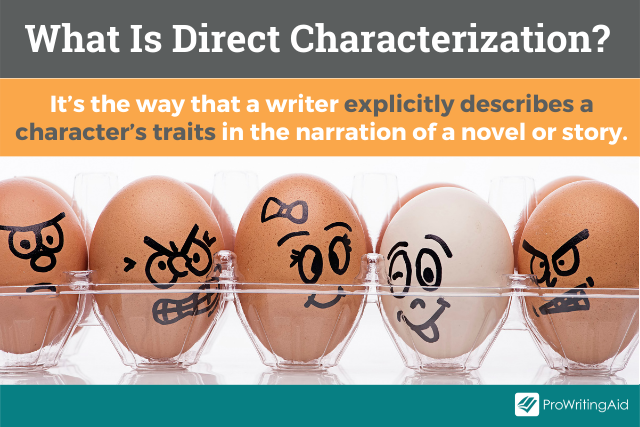
Direct characterization contrasts with indirect characterization, which refers to the way a writer shows a character’s traits through dialogue and action.
If you want to convey a character’s generosity with indirect characterization, for example, you might show the character lending money to a stranger in need.
If you want to convey a character’s bad temper with indirect characterization, you might show them slamming a door or shouting at their kids.

Here’s an example of what that might look like in writing:
- Direct characterization: Edmund was a snobby boy who looked down on his classmates.
- Indirect characterization: Edmund sneered at his classmates and said, "You’re just jealous because I’m better than you."
In the direct characterization example, the author explicitly states that Edmund is snobby.
In the indirect characterization example, the author shows Edmund’s snobbery through his actions and dialogue.
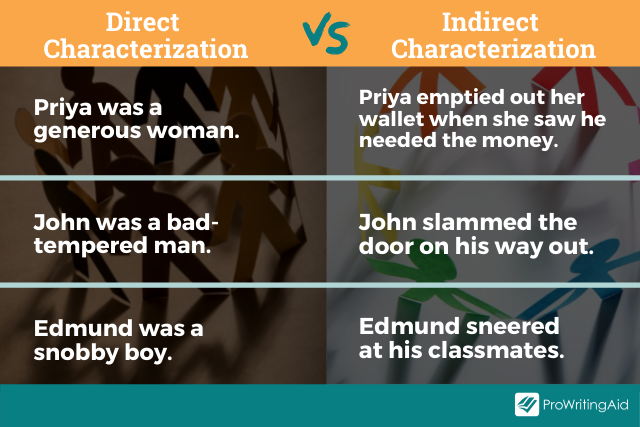
Both of these techniques are useful tools.
Use direct characterization for the most important aspects of character development, such as what the character looks like and what their personality is like.
Use indirect characterization to give the reader a deeper understanding of the character in a less straightforward manner as the story progresses.
You can do this by balancing seemingly unimportant back narrative with the immediate action of your story.
ProWritingAid’s Pacing Report makes this process so much easier than going about it blind by giving you a visual representation of the overall pacing of your novel.
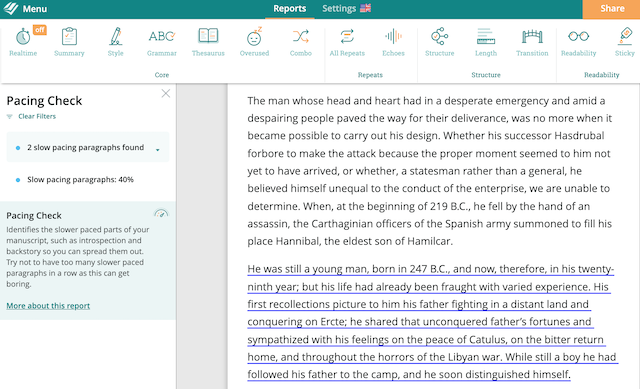
There are many details an author can include in direct characterization.
Direct characterization can include the character’s physical description, such as:
- What they look like
- What they’re wearing
- Their mannerisms and gestures
Direct characterization can also include the details of a character’s inner world, such as:
- Their interests and hobbies
- What they want
- What they fear
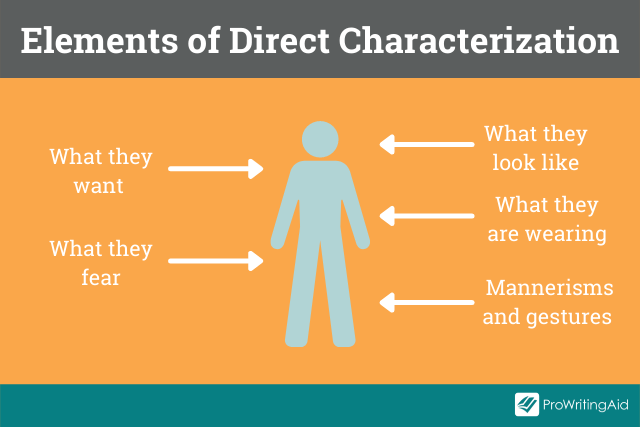
Let’s take a look at ten examples from literature.
1. The Name of the Wind by Patrick Rothfuss
Elodin was younger than the others by at least a dozen years. Clean-shaven with deep eyes. Medium height, medium build, there was nothing particularly striking about him, except for the way he sat at the table, one moment watching something intently, the next minute bored and letting his attention wander among the high beams of the ceiling above. He was almost like a child who had been forced to sit down with adults.
In this paragraph, Patrick Rothfuss introduces Elodin, the Master Namer at the University.
We see that Elodin both looks like a child ("younger than the others," "clean-shaven") and behaves like a child ("bored and letting his attention wander").
Rothfuss uses Elodin’s surprising appearance and mannerisms to convey his eccentric personality.

2. Radiance by Catherynne M. Valente
I am always honest about my capabilities. I am very pretty, though my prettiness lacks depth and therefore misses beauty by a hair. I have an extremely expressive face that I can contort at will. I am short, but I have a serviceable chest and practically perfect calves. For stage work I have a rich voice which carries well, though it is somewhat deeper than the fashion. I can alter it somewhat. I can pass for an American or a Frenchwoman, and I am working on a Muscovite lilt. Perhaps at twenty I shall be a superb dancer. Perhaps at thirty I shall be beautiful. Anything is possible.
This passage is an example of direct characterization in a first-person POV (point of view).
In spite of the first sentence of this paragraph, we have no way of knowing if the narrator is giving an honest assessment—we can only see her the way she sees herself.
We find out that she sees herself as pretty but not quite beautiful ("my prettiness lacks depth," "I am short," "I have a serviceable chest").
We also see that she’s confident she can adapt to the needs of the stage ("I have a rich voice which carries well... I can pass for an American or a Frenchwoman").
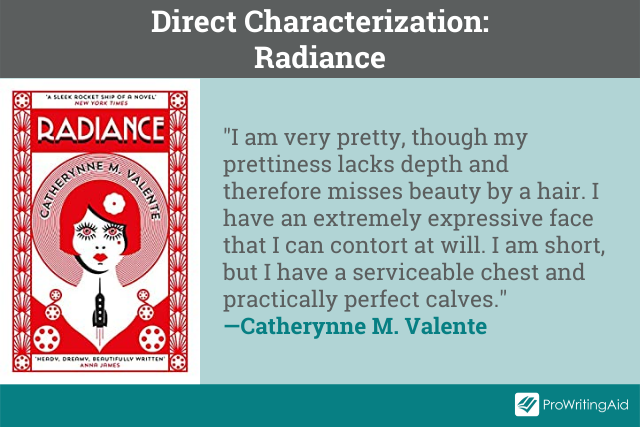
3. Going Postal by Terry Pratchett
People had difficulty describing him. He was… he was “about.” He was about twenty, or about thirty. On Watch reports across the continent he was anywhere between, oh, about six feet two inches and five feet nine inches tall, hair all shades from mid-brown to blond, and his lack of distinguishing features included his entire face. He was about… average. What people remembered was the furniture, things like spectacles and mustaches, so he always carried a selection of both. They remembered names and mannerisms, too. He had hundreds of those. Oh, and they remembered that they’d been richer before they met him.
This passage is Terry Pratchett’s description of Moist, an experienced conman and scammer.
Moist’s surface traits, which are described as average in every possible way ("His lack of distinguishing features included his entire face"), show the reader how well he’s perfected his profession ("They’d been richer before they met him").
This is a great example of a physical description that speaks to something deeper than the surface.

4. The Secret History by Donna Tartt
Bunny, for all his appearance of amiable, callous stability, was actually a wildly erratic character. There were any number of reasons for this, but primary among them was his complete inability to think about anything before he did it. He sailed through the world guided only by the dim lights of impulse and habit, confident that his course would throw up no obstacles so large that they could not be plowed over with sheer force of momentum.
In this passage, Donna Tartt describes Bunny’s personality.
We learn that he’s the type of person who makes decisions based on habit rather than forethought ("He sailed through the world guided only by the dim lights of impulse and habit").
Tartt also uses indirect characterization in other scenes of The Secret History to show us Bunny’s impulsivity, but this paragraph of direct characterization helps cement that personality trait in a more obvious way.

5. Gorky Park by Martin Cruz Smith
Wesley was tall, young and balding, smooth-featured as if rolled like a pebble, with a faint and meaningless expression of affability. He wore a three-piece suit of blue material. Scents of lime and mint came from Wesley’s mouth, cheeks and armpits. For the entire flight he had crossed his legs and smoked a pipe and answered Arkady’s questions with grunts. There was something awkward and milk-fed about Wesley, like a calf.
Martin Cruz Smith uses sight ("tall, young and balding," "smooth-featured," "three-piece suit of blue material"), sound ("answered Arkady’s questions with grunts"), and even smell ("scents of lime and mint") to describe Wesley, a CIA operative.
We get a comprehensive mental image of Wesley as an awkward and smooth-featured young man, which sets him apart from our pre-existing stereotypes of what a CIA operative might look like.

6. Everything I Never Told You by Celeste Ng
With Nath gone, Hannah followed Lydia like a puppy, scampering to her door each morning before Lydia’s clock radio had even gone off, her voice breathless, just short of a pant. Guess what? Lydia, guess what? It was never guessable and never important: it was raining; there were pancakes for breakfast; there was a blue jay in the spruce tree. Each day, all day, she trailed Lydia suggesting things they could do—We could play Life, we could watch the Friday Night Movie, we could make Jiffy Pop. All her life, Hannah had hovered at a distance from her brother and sister, and Lydia and Nath had tacitly tolerated their small, awkward moon. Now Lydia noticed a thousand little things about her sister: the way she twitched her nose once-twice, fast as a rabbit, when she was talking; the habit she had of standing on her toes, as if she had invisible high heels.
In this passage, Celeste Ng describes Hannah, the annoying but lovable little sister.
We see all the ways she begs her older sister Lydia for attention ("Guess what, Lydia? Guess what?"), following her around the house.
We also see Lydia beginning to notice her for the first time ("Now Lydia noticed a thousand little things about her sister"), since this paragraph is told from Lydia’s third-person perspective.
In the process, we learn something about both sisters and how their relationship is changing.

7. The History of Love by Nicole Krauss
Bruno, my old faithful. I haven’t sufficiently described him. Is it enough to say he is indescribable? No. Better to try and fail than not to try at all. The soft down of your white hair lightly playing about your scalp like a half-blown dandelion. Many times, Bruno, I have been tempted to blow on your head and make a wish. Only a last scrap of decorum keeps me from it. Or perhaps I should begin with your height, which is very short. On a good day you barely reach my chest. Or shall I start with the eyeglasses you fished out of a box and claimed as your own, enormous round things that magnify your eyes so that your permanent response appears to be a 4.5 on the Richter? They’re women’s glasses, Bruno! I’ve never had the heart to tell you.
In this passage, we see us a physical description of Bruno, the narrator’s best friend, narrated in second person.
The traits he chooses to mention are unique and memorable ("your white hair lightly playing about your scalp," "the eyeglasses you fished out of a box").
They’re also interspersed with commentary from the narrator that make it clear how he feels about Bruno—a rare mix of affection and exasperation ("They’re women’s glasses, Bruno!").
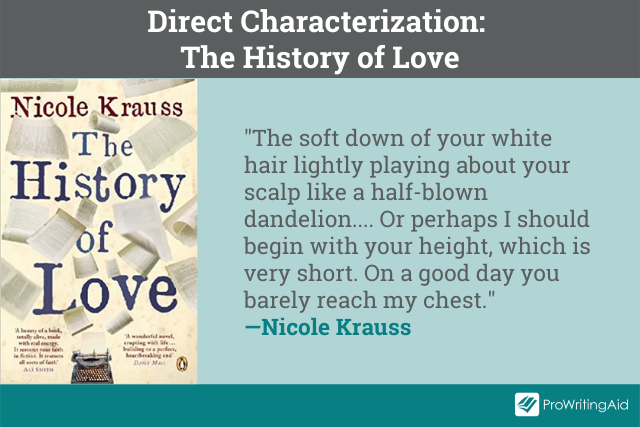
8. Sea Wife by Amity Gaige
Sybil’s face is heart-shaped, wide at the temples, with a small, emphatic chin. The truth is, it’s her father’s face. Distantly Finnish, midwestern, wide open and friendly. You can almost sense the ball fields and the Coca-Cola and the square dances that it took to produce that kind of a face.
In this passage, Amity Gaige describes Sybil’s physical appearance, drawing on cultural references ("ball fields," "Coca-Cola," "square dances").
Even though the description mostly focuses on Sybil’s face, we also get a clear sense of what Sybil’s personality is like.
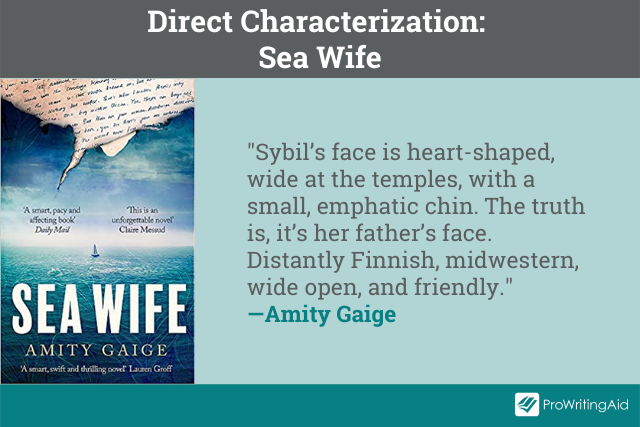
9. All the Light We Cannot See by Anthony Doerr
But seven-year-old Werner seems to float. He is undersized and his ears stick out and he speaks with a high, sweet voice; the whiteness of his hair stops people in their tracks. Snowy, milky, chalky. A color that is the absence of color. Every morning he ties his shoes, packs newspaper inside his coat as insulation against the cold, and begins interrogating the world. He captures snowflakes, tadpoles, hibernating frogs; he coaxes bread from bakers with none to sell; he regularly appears in the kitchen with fresh milk for the babies. He makes things too: paper boxes, crude biplanes, toy boats with working rudders.
In this passage, Anthony Doerr introduces us to Werner, an unusual child with white hair and an extremely curious mind.
Though his physical traits are arresting, it’s Werner’s physical habits and mannerisms ("he captures snowflakes, tadpoles, hibernating frogs," "he makes things") that ultimately show us what kind of child he is.
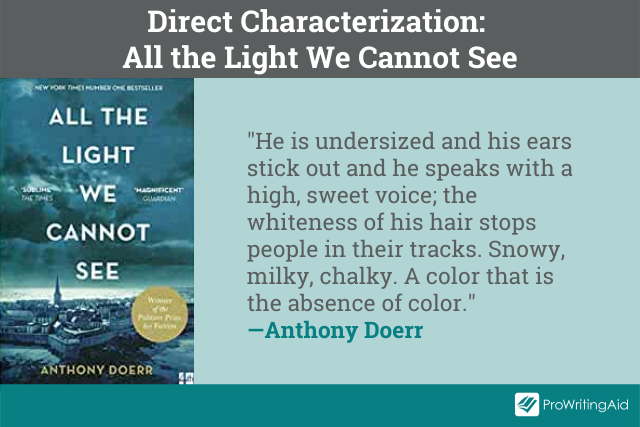
10. Or What You Will by Jo Walton
He had expected her to be passably attractive, with the bloom of a young girl, but the face she shows when she draws back her veil is like a Madonna painted by a great master, beautiful and sad and wise. He can see her fair hair glinting under the cloth draped over her head, and the black clothes she wears enhance the elegance of her trim figure. She is certainly young, Orsino thinks, staring at her, but she is ripe like a peach. You would paint her as summer rather than spring, an orchid rather than a snowdrop, a queen rather than a princess, Juno rather than Diana.
In this passage, Jo Walton shows us this character using a variety of comparisons and similes ("a Madonna," "a peach," "an orchid," "a queen").
Through the mental associations we have with each of these comparisons, we get a sense of the character.

When used well, direct characterization can help you present a realistic and fully fleshed-out version of your characters.
Here are some questions to ask yourself when you’re using direct characterization.
What External Traits Do I Need to Show for This Character?
Showing a character’s physical description is especially necessary the first time we meet a new character.
Get as specific as you can. If your character is wearing a dress, tell us what kind of dress. If your character has red hair, tell us what shade of red.
Ask yourself:
- What parts of the character’s outward appearance say something about their personality? (e.g. scarred hands, deep wrinkles, sun-tanned skin)
- What traits does this character have that are specific and memorable? (e.g. shockingly red hair)
- Do they have any defining gestures? (e.g. biting their nails when they’re nervous)

What Internal Traits Do I Need to Show for This Character?
Direct characterization is especially important for information relevant to the character’s motivation or growth.
- What’s this character’s personality like?
- What’s their character arc / transformation going to be?
- What does this character want or fear?

If the story is narrated by another character, then all instances of direct characterization should reflect how that character thinks.
For example, the way Cinderella’s stepsisters describe Cinderella would be very different from the way Prince Charming describes Cinderella.
The former might sound envious and cruel, while the latter might sound admiring and romantic.
You can, in a sense, describe two characters at once by letting the narrator’s voice color their description.
Say you’re trying to use direct characterization to describe a character’s intelligence.
If this character’s intelligence makes the narrator feel inferior, you can describe their intelligence in a negative way ("She was a nerdy weirdo").
If this character’s intelligence makes the narrator feel awed, you can describe their intelligence in a positive way ("She was a brilliant scientist").
Doing so will tell you not just that this character is intelligent, but also how the narrator sees themselves in relation to this character’s intelligence.
- Is this passage of direct narration told through the mind of the narrator, another character, or an anonymous storyteller?
- How does that character feel about the character being described?
- What aspects of the character being described are they most likely to notice, and why?
Final Thoughts
Those are some of our favorite tips for using direct characterization in fiction writing.
What are your favorite ways to describe your characters? Let us know in the comments.
Do you know how to craft memorable, compelling characters? Download this free book now:
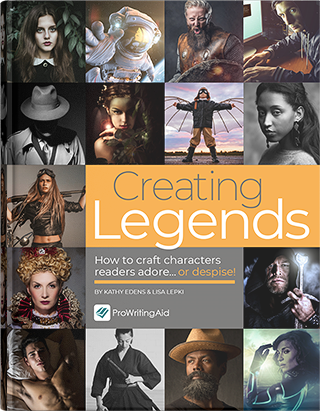
Creating Legends: How to Craft Characters Readers Adore… or Despise!
This guide is for all the writers out there who want to create compelling, engaging, relatable characters that readers will adore… or despise., learn how to invent characters based on actions, motives, and their past..

Be confident about grammar
Check every email, essay, or story for grammar mistakes. Fix them before you press send.
Hannah Yang
Hannah Yang is a speculative fiction writer who writes about all things strange and surreal. Her work has appeared in Analog Science Fiction, Apex Magazine, The Dark, and elsewhere, and two of her stories have been finalists for the Locus Award. Her favorite hobbies include watercolor painting, playing guitar, and rock climbing. You can follow her work on hannahyang.com, or subscribe to her newsletter for publication updates.
Get started with ProWritingAid
Drop us a line or let's stay in touch via :

Characterization

Characterization Definition
What is characterization? Here’s a quick and simple definition:
Characterization is the representation of the traits, motives, and psychology of a character in a narrative. Characterization may occur through direct description, in which the character's qualities are described by a narrator, another character, or by the character him or herself. It may also occur indirectly, in which the character's qualities are revealed by his or her actions, thoughts, or dialogue.
Some additional key details about characterization:
- Early studies of literature, such as those by the ancient Greek philosopher Aristotle, saw plot as more important than character. It wasn't until the 15th century that characters, and therefore characterization, became more crucial parts of narratives.
- Characterization became particularly important in the 19th century, with the rise of realist novels that sought to accurately portray people.
Characterization Pronunciation
Here's how to pronounce characterization: kar-ack-ter-ih- zey -shun
Direct and Indirect Characterization
Authors can develop characterization in two ways: directly and indirectly. It's important to note that these two methods are not mutually exclusive. Most authors can and do use both direct and indirect methods of characterization to develop their characters.
Direct Characterization
In direct characterization, the author directly describes a character's qualities. Such direct description may come from a narrator, from another character, or through self-description by the character in question. For instance, imagine the following dialogue between two characters:
"That guy Sam seems nice." "Oh, no. Sam's the worst. He acts nice when you first meet him, but then he'll ask you for money and never return it, and eat all your food without any offering anything in return, and I once saw him throw a rock at a puppy. Thank God he missed."
Here the second speaker is directly characterizing Sam as being selfish and cruel. Direct characterization is also sometimes called "explicit characterization."
Indirect Characterization
In indirect characterization, rather than explicitly describe a character's qualities, an author shows the character as he or she moves through the world, allowing the reader to infer the character's qualities from his or her behavior. Details that might contribute to the indirect characterization of a character are:
- The character's thoughts.
- The character's actions.
- What a character says (their choice of words)
- How a character talks (their tone, dialect, and manner of speaking)
- The character's appearance
- The character's movements and mannerisms
- How the character interacts with others (and how others react to the character)
Indirect characterization is sometimes called "implicit characterization."
Indirect Characterization in Drama
It's worth noting that indirect characterization has an additional layer in any art form that involves actors, including film, theater, and television. Actors don't just say the words on the script. They make choices about how to say those words, how to move their own bodies and in relation to other character. In other words, actors make choices about how to communicate all sorts of indirect details. As a result, different actors can portray the same characters in vastly different ways.
For instance, compare the way that the the actor Alan Bates plays King Claudius in this play-within-a-play scene from the 1990 movie of Hamlet, versus how Patrick Stewart plays the role in the same scene from a 2010 version. While Bates plays the scene with growing alarm and an outburst of terror that reveals his guilt, Stewart plays his Claudius as ice cold and offended, but by no means tricked by Hamlet's little play-within-a-play into revealing anything.
Round and Flat Characters
Characters are often described as being either round or flat.
- Round characters : Are complex, realistic, unique characters.
- Flat characters : Are one-dimensional characters, with a single overarching trait and otherwise limited personality or individuality.
Whether a character is round or flat depends on their characterization. In some cases, an author may purposely create flat characters, particularly if those characters will appear only briefly and only for a specific purpose. A bully who appears in a single scene of a television show, for instance, might never get or need more characterization than the fact that they act like a bully.
But other times authors may create flat characters unintentionally when round characters were necessary, and such characters can render a narrative dull, tensionless, and unrealistic.
Character Archetypes
Some types of characters appear so often in narratives that they come to seen as archetypes —an original, universal model of which each particular instance is a kind of copy. The idea of the archetype was first proposed by the psychologist Carl Jung, who proposed that there were twelve fundamental "patterns" that define the human psyche. He defined these twelve archetypes as the:
While many have disagreed with the idea that any such twelve patterns actually psychologically define people, the idea of archetypes does hold a lot of sway among both those who develop and analyze fictional characters. In fact, another way to define round and flat character is to think about them as they relate to archetypes:
- Flat characters are easy to define by a single archetype, and they do not have unique personal backgrounds, traits, or psychology that differentiates them from that archetype in a meaningful way.
- Round characters may have primary aspects that fit with a certain archetype, but they also may be the combination of several archetypes and also have unique personal backgrounds, behaviors, and psychologies that make them seem like individuals even as they may be identifiable as belonging to certain archetypes.
Good characterization often doesn't involve an effort to avoid archetype altogether—archetypes are archetypes, after all, because over human history they've proved to be excellent subjects for stories. But successful authors will find ways to make their characters not just archetypes. They might do so by playing with or subverting archetypes in order to create characters who are unexpected or new, or more generally create characters whose characterization makes them feel so unique and individual that their archetype feels more like a framework or background rather than the entirety of who that character is.
Characterization Examples
The characters of nearly every story—whether in literature, film, or any other narrative—have some characterization. Here are some examples of different types of characterization.
Characterization in Hamlet
The famous literary critic Harold Bloom has argued in his book The Invention of the Human that "Personality, in our sense, is a Shakespearean invention." Whether or not you agree with that, there's no doubting that Shakespeare was a master of characterization. One way he achieved such characterization was through his characters delivering soliloquies . The excerpt of a soliloquy below is from Hamlet , in which Hamlet considers suicide:
To be, or not to be? That is the question— Whether ’tis nobler in the mind to suffer The slings and arrows of outrageous fortune, Or to take arms against a sea of troubles, And, by opposing, end them? To die, to sleep— No more—and by a sleep to say we end The heartache and the thousand natural shocks That flesh is heir to—’tis a consummation Devoutly to be wished! To die, to sleep. To sleep, perchance to dream—ay, there’s the rub, For in that sleep of death what dreams may come When we have shuffled off this mortal coil, Must give us pause.
Hamlet's soliloquy is not simply him saying what he thinks. As he delivers the soliloquy, he discovers what he thinks. When he says "To die, to sleep. To sleep," he is all-in on the idea that suicide is the right course. His words "perchance to dream" flow directly out of his thoughts about death as being like "sleep." And with his positive thoughts of death as sleep, when he first says "perchance to dream" he's thinking about having good dreams. But as he says the words he realizes they are deeper than he originally thought, because in that moment he realizes that he doesn't actually know what sort of dreams he might experience in death—they might be terrible, never-ending nightmares. And suddenly the flow of his logic leaves him stuck.
In showing a character experiencing his own thoughts the way that real people experience their thoughts, not as a smooth flow but as ideas that spark new and different and unexpected ideas, Shakespeare gives Hamlet a powerful humanity as a character. By giving Hamlet a soliloquy on the possible joy of suicide he further captures Hamlet's current misery and melancholy. And in showing how much attention Hamlet pays to the detail of his logic, he captures Hamlet's rather obsessive nature. In other words, in just these 13 lines Shakespeare achieves a great deal of characterization.
Characterization in The Duchess of Malfi
In his play the The Duchess of Malfi , John Webster includes an excellent example of direct characterization. In this speech, the character Antonio tells his friend about Duke Ferdinand:
The Duke there? A most perverse and turbulent nature; What appears in him mirth is merely outside. If he laugh heartily, it is to laugh All honesty out of fashion. … He speaks with others' tongues, and hears men's suits With others' ears; will seem to sleep o’th' bench Only to entrap offenders in their answers; Dooms men to death by information, Rewards by hearsay.
Ferdinand directly describes the Duke as deceitful, perverse, and wild, and as a kind of hollow person who only ever laughs for show. It is a devastating description, and one that turns out to be largely accurate.
Characterization in The Great Gatsby
Here's another example of direct characterization, this time from The Great Gatsby . Here, Nick Carraway, the narrator of the novel, describes Tom and Daisy Buchanan near the end of the novel.
They were careless people, Tom and Daisy—they smashed up things and creatures and then retreated back into their money or their vast carelessness, or whatever it was that kept them together, and let other people clean up the mess they had made.
But The Great Gatsby, like essentially all other literature, doesn't solely rely on direct characterization. Here is Nick, earlier in the novel, describing Gatsby:
He stretched out his arms toward the dark water in a curious way, and, far as I was from him, I could have sworn he was trembling. Involuntarily I glanced seaward—and distinguished nothing except a single green light, minute and far away, that might have been the end of a dock.
This is an example of indirect characterization. Nick isn't describing Gatsby character directly, instead he's describing how Gatsby is behaving, what Gatsby is doing. But that physical description—Gatsby reaching out with trembling arms toward a distant and mysterious green light—communicates fundamental aspects of Gatsby's character: his overwhelming yearning and desire, and perhaps also the fragility inherent such yearning.
Why Do Writers Use Characterization?
Characterization is a crucial aspect of any narrative literature, for the simple reason that complex, interesting characters are vital to narrative literature. Writers therefore use the techniques of characterization to develop and describe characters':
- Motivations
- History and background
- Interests and desires
- Skills and talents
- Self-conception, quirks, and neuroses
Such characteristics in turn make characters seem realistic and also help to drive the action of the plot, as a plot is often defined by the clash of actions and desires of its various characters.
Other Helpful Characterization Resources
- Wikipedia entry on characterization: A brief but thorough entry.
- Archetypal characters: The website TV tropes has built a vast compendium of different archetypal characters that appear in film and television (and by extension to books).
- Encyclopedia Britannica on characters: A short entry on flat and round characters.
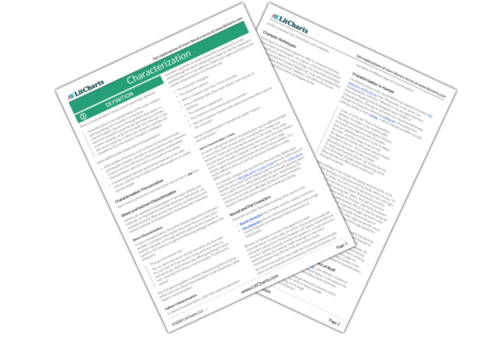
- PDFs for all 136 Lit Terms we cover
- Downloads of 1970 LitCharts Lit Guides
- Teacher Editions for every Lit Guide
- Explanations and citation info for 41,543 quotes across 1970 books
- Downloadable (PDF) line-by-line translations of every Shakespeare play
- Flat Character
- Round Character
- Tragic Hero
- Anadiplosis
- Onomatopoeia
- End-Stopped Line
- Blank Verse
- Epanalepsis


Direct characterization tells the audience what a character is like; Indirect characterization shows traits through actions, thoughts, and dialogue.
Direct characterization 🗣️.
Direct characterization is straightforward: the narrator explicitly describes the character’s personality, values, or physical attributes. This approach leaves little to the imagination, providing clear insights into the character . For example, in The Great Gatsby by F. Scott Fitzgerald, Nick Carraway describes Jay Gatsby as “incredibly handsome, enormously wealthy, and mysteriously mysterious,” offering a direct insight into Gatsby’s character .
Indirect Characterization 🕵️
Indirect characterization requires the reader to infer a character’s traits from their actions, words, decisions, and interactions with others. It’s like piecing together a puzzle, where each piece contributes to a fuller understanding of the character . In Harper Lee’s To Kill a Mockingbird , Atticus Finch’s integrity and moral fortitude are shown through his actions, like his defense of Tom Robinson, rather than through direct statements about his character .
| Literary Device | Definition | Purpose | Usage | Relevant Examples |
|---|---|---|---|---|
| explicitly describes a | To clearly define a for reader | Straightforward narratives, introductions | Great Gatsby by F. Scott Fitzgerald | |
| Traits revealed through actions and | To allow readers to deduce traits | Complex narratives, character-driven stories | by Harper Lee |
Writing Tips
- For Direct Characterization : Use it sparingly to avoid over-explaining. It’s most effective when introducing characters or highlighting key traits that might not be evident through actions alone.
- For Indirect Characterization : Show, don’t tell. Use your characters’ interactions, choices, and conflicts to reveal who they are. This approach can create more engaging and relatable characters.
Q: Can a story use both direct and indirect characterization ? A: Yes, most stories benefit from a mix of both to create a well-rounded narrative .
Q: Is one method better than the other? A: Neither is inherently better; the choice depends on the story’s needs and the writer’s style .
Q: How can I improve my indirect characterization skills? A: Practice writing scenes that show your characters’ traits through their decisions, dialogue , and how others react to them.
Read the following excerpt and identify whether it’s an example of direct or indirect characterization :
“John always arrived early at meetings, prepared with a list of ideas and questions. He often stayed late to help colleagues with their projects, even if it meant delaying his own work.”
Answer: Indirect characterization .

Other Device Comparisons You May Find Interesting
- Show vs Tell : Enhancing narrative through demonstration versus exposition .
- Dynamic vs Static Characters : Understanding character development over time.
- Foreshadowing vs Flashback : Techniques for enriching the narrative with past and future elements.
- First-Person vs Third-Person Narration : The impact of narrative perspective on storytelling.
Exploring these literary devices can further enhance your writing and reading experiences, offering new insights into the craft of storytelling.
The Art of Narrative
Learn to write.
Direct Characterization Vs. Indirect Characterization
Direct characterization vs. indirect characterization. What’s the difference? Learn how to use both techniques to improve your writing!
Do you want to write characters that are worth reading?
Keeping your readers engaged with compelling, intriguing characters comes down to one critical skill- an author’s ability to describe their characters through direct and indirect characterization. That’s precisely what you’re going to learn how to do today.
Keep reading to learn what direct and indirect characterization is, how and why authors use indirect and direct characterization, and how you can use both in your writing! We’ll also examine some classic literary examples of both types of characterization. As usual, at the bottom, you can find more resources on creating fantastic characters.
Let’s get started with the basics.
Definition of Characterization
Characterization is when the author describes a character. Simple, right? Through characterization, an author describes all the crucial details about that character. An author will describe physical traits like hair and eye color, or what a character is wearing. Authors will also cover aspects of a character’s personality, behavior, and motivation.
Characterization Describes:
- A character’s physical attributes
- A character’s personality
- A character’s action and behavior
- A character’s motivation
There are two techniques that storytellers use to illustrate engaging characters. These techniques are-
- Direct Characterization
- Indirect Characterization
Both direct characterization and indirect characterization have their place in a story, and neither one is preferable to the other. Instead, both forms of description can perform specific tasks in your story for which they are well suited.
Let’s define direct and indirect characterization, and talk about how and when to use each technique. We’ll also take a look at some expert examples of both indirect and direct characterization.
What is Direct Characterization?
Direct Characterization is when the writer describes a character directly to the reader…through narration.
Direct characterization is when a writer describes a character directly to the reader, usually through narration. The author will tell the reader details about the character. These details will include things like the character’s physical appearance, personality, and what motivates the character.
Example of direct characterization
Here is an excellent example of direct characterization from Richard Connell’s famous short story, The Most Dangerous Game. In this passage, the story’s protagonist, Sanger Rainsford, describes his first encounter with General Zaroff, his antagonist.
“Rainsford’s first impression was that the man was singularly handsome; his second was that there was an original, almost bizarre quality about the general’s face. He was a tall man past middle age, for his hair was a vivid white; but his thick eyebrows and pointed military mustache were as black as the night from which Rainsford had come. His eyes, too, were black and very bright. He had high cheekbones, a sharpcut nose, a spare, dark face–the face of a man used to giving orders, the face of an aristocrat.”
From the author’s use of direct characterization, readers can tell a lot about the character of Zaroff. The general is wealthy, and he has a military background. Zaroff is also authoritative, and words like “high,” “sharpcut,” and “dark” lead us to believe Zaroff is both intelligent and possibly a nefarious man.
How to write direct characterization
Writing direct characterization is straightforward. You describe the details that make up your character with narration. The points you include can be anything you think is vital for the reader to know about your character.
What does that mean?
The details you choose to share about your character should give the reader an insight into the character’s inner workings or the plot of your story. Take a look at the example above, where the author describes General Zaroff’s face. Connell describes Zaroff as having sharp and dark features. It’s not a surprise to the reader that Zaroff turns out to be the story’s main antagonist because words like ‘sharp’ and ‘dark’ have a negative connotation.
This example teaches us that word choice is important when describing a character. Had the author described Zaroff as having a round face and bulbous nose, the character would cut a far less intimidating figure. Think about the words used and how readers will interpret those words in the context of character description.
When writing direct characterization for your characters, be sure to add details that will give your reader clues into a character’s personality. If you’re writing a character who is a neat freak and borderline OCD, then they should dress in a pair of fitted, pressed, and clean slacks.
When to use direct characterization
Use direct characterization when first introducing a character to your readers. When a new character enters your story arc, you can use direct characterization to give readers the most important details about that character. Share the elements of a character’s personality that will impact the story, but don’t give away too much. You need to save some characterization for the reader to discover on their own. More on that, when we talk about indirect characterization.
You can also use direct characterization to create a stark contrast between two characters, say two characters who are foils of each other. If your protagonist is cold and distant, but their best friend is kind and giving, then use narration to point out this contrast. Of course, you’ll want to use character behavior and indirect characterization to show these character details as the story progresses.
This example leads to the question:
What is Indirect Characterization?
The author shows the character’s thoughts, actions, and interactions to add depth to that character.
When using indirect characterization, the author shows the character’s thoughts, actions, speech, and interactions to add depth to that character. The reader will draw reasonable conclusions based on how the character behaves.
With indirect characterization, the reader must pay attention to a character’s actions and do a little detective work to discover who that character is as a person. Indirect characterization will give your story depth and give your reader something to do. Remember that reading should not be a passive act. Readers want to figure things out on their own.
Example of Indirect Characterization.
Let’s take a look at a dialogue between the characters of Rainsford and Whitney in The Most Dangerous Game :
“The best sport in the world,” agreed Rainsford.
“For the hunter,” amended Whitney. “Not for the jaguar.”
“Don’t talk rot, Whitney,” said Rainsford. “You’re a big-game hunter, not a philosopher. Who cares how a jaguar feels?”
“Perhaps the jaguar does,” observed Whitney.
“Bah! They’ve no understanding.” “Even so, I rather think they understand one thing–fear. The fear of pain and the fear of death.”
“Nonsense,” laughed Rainsford. “This hot weather is making you soft, Whitney. Be a realist. The world is made up of two classes–the hunters and the huntees. Luckily, you and I are hunters.”
The interaction between Whitney and Rainsford tells us important information about our protagonist, Rainsford. Whitney, a minor character in the story, acts as a foil to Rainsford by disagreeing with Rainsford’s worldview.
Read more about character foils here.
We learn that Rainsford, unlike Whitney, has no respect for the animals he hunts. He believes the world is made of hunters and the hunted and that his prey deserves no pity or respect. This idea plays heavily into the theme of the story and Rainsford’s ultimate fate.
How to write indirect characterization
When writing indirect characterization, one of your first tools will be dialogue. The dialogue a character uses says a lot about the person they are. Through discussion, characters can express their worldview, as Rainsford does in our example above.
You’re also going to rely on a character’s behavior to demonstrate important aspects of that character’s personality. For instance, if you wanted readers to understand that your main antagonist is, really, terrible, you could have the character kick a puppy. It doesn’t get much worse than that.
Think about how characters react to each other when writing indirect characterization. Suppose your antagonist is “puppy-kicking” awful. In that case, the people around him will keep their distance and be uneasy when interacting with him.
Finally, you can use a character’s inner monologue to give your readers a deeper understanding of a character’s motivation. If a character kicks a puppy, your reader will naturally ask why. The great thing about fiction writing is that you can answer that question by giving readers a glimpse into a character’s thoughts. Maybe, your antagonist despises weakness because she fears returning to a time in life when she was weak. That is something you can explore and explain through a character’s thoughts.
When to use an indirect characterization
An often-used piece of advice given to fiction writers is to show don’t tell. This rule means that you should establish a character’s personality through their actions, dialogue, thoughts, and interactions rather than stating facts about your character through narration.
Once you’ve introduced a character and used direct characterization to give the reader a few key details, use indirect characterization to show and not tell. Use indirect characterization to reinforce the details you’ve provided about a character’s personality, or when you reveal new facts about your character.
Use indirect characterization so that your reader can discover a character on their own. Readers will grow bored when an author continues to tell them what a character is like. Readers want to see what a character does and hear what a character says and draw conclusions about that character.
Ultimately, readers want to discover the details of your story on their own. It is the author’s job to dole out enough clues so that a reader makes the correct assumptions about a character.
Plot twists are another way that writers give their readers a sense of discovery. Read more about plot twists here!
Use indirect characterization after you’ve introduced a character to reinforce your direct characterization. If you introduce a character by saying that the character has a kind face, then use indirect characterization to show that character doing kind things.
Ok, that’s a wrap on direct and indirect characterization, for now. But that’s by no means all there is to say on the subject of writing characters. If you want to learn more, check out the Art of Narrative “character” tab here .
Or, check out below, where you’ll find more resources on writing characters from around the internet. And, finally, feel free to drop the infographic below on your website! Just right-click, then copy and paste the Html code.
What’s your favorite method for characterization? Let me know in the comments!
Read more about characterization:
Master Class- Direct Characterization: Definition, Examples, and Direct vs. Indirect Characterization
Learn about first-person point of view here!
This post contains affiliate links to products. We may receive a commission for purchases made through these links
Published by John
View all posts by John
4 comments on “Direct Characterization Vs. Indirect Characterization”
Excellent advice as always, John.
- Pingback: How to Fix a Mary Sue Character - The Art of Narrative
- Pingback: Indirect Characterization || Explore Detailed Information – News81
Leave a Reply Cancel reply
Copy and paste this code to display the image on your site
Discover more from The Art of Narrative
Subscribe now to keep reading and get access to the full archive.
Type your email…
Continue reading
Characterization
Characterization definition, types of characterization.
This is a more subtle way of introducing the character to the audience. The audience has to deduce for themselves the characteristics of the character by observing his/her thought process, behavior, speech, way of talking, appearance, and manner of communication with other characters, as well as by discerning the response of other characters.
Characterization in Drama
Importance of characterization, everyday examples of characterization , difference archetypes and characterization, difference between characterization and stereotypes, round and flat characters .
Round Characters are complex characters. They undergo a considerable transformation during their work or life in the storyline. They, sometimes, cause shock and surprise the readers and seem to them interesting. However, flat characters are not very complex as they are just two-dimensional. They are simple and often stay the same throughout the storyline.
Characterization in Stories
Examples of characterization in literature, example #1: the great gatsby by f. scott fitzgerald.
Occupations have also been used very tactfully in the novel to highlight the characteristics of certain protagonists. The prime example is Gatsby who, despite being so rich, is known for his profession: bootlegging. He had an illegal job that earned him a fortune but failed to get him into the upper class of New York society. In contrast , Nick has a clean and fair job as a “bondman” that defines his character. The poor guy Wilson, who fixes rich people’s cars, befriends his wife; and then there is Jordon, who is presented as a dishonest golf pro.
Function of Characterization
Synonyms of characterization, related posts:, post navigation.
Writing Characterization: A Step-By-Step Guide To Unleashing Your Inner Fitzgerald
Check out our guide to learn how writing characterization can work to your advantage for creating compelling characters your readers will connect with instantly.
Characterization is the process of providing your readers with the information they need to get to know your characters. Good characterization can help a writer develop complex characters with personality traits and a physical appearance that readers can easily picture. Bold characterization can instantly give us a sense of the character’s nature. For example, Phillip Pullman is a master at characterization.
“Lord Asriel was a tall man with powerful shoulders, a fierce dark face, and eyes that seemed to flash and glitter with savage laughter. It was a face to be dominated by, or to fight: never a face to patronize or pity. All his movements were large and perfectly balanced, like those of a wild animal, and when he appeared in a room like this, he seemed a wild animal held in a cage too small for it.” Philip Pullman, The Golden Compass
Whether you’re working on a screenwriting project, a short story, or a novel, flat characters are the enemy of a solid writing process. Indirect characterization and direct characterization give your reader the information they need to understand more about your character’s motivations, thoughts, and feelings.
What is Characterization?
Before you start, revealing your character’s personality, direct characterization, indirect characterization, 1. understand your character, 2. balance implicit and explicit characterization methods, 3. give all characters a purpose, 4. let your characters learn.

Before we dive into understanding the different types of characterization, it’s key that you understand the characterization definition in literature. During the characterization process, you’re explaining and revealing details about your main character (and likely your peripheral characters) to allow your readers to understand their personalities, lives, goals, relationships, feelings, and motivations.
Good characterization happens over time. A single paragraph at the beginning of your story can be an excellent start to helping your reader get to know your main character, but character development takes place over the entire course of your novel. Check out these writing organizational patterns .
Just as it will take your readers time to get to know your character, you’ll also need to take the time to flesh out exactly who they are before you can make them appear natural. Getting to know your characters can start by picturing them in your mind and going through an imaginary interview.
Imagine how your character speaks, how they answer your questions, what they’re wearing, and how your questions make them feel emotional. Providing your readers with information on your character’s backstory can help them understand how your character’s choices align with their past experiences. Some smart questions to ask your characters in your imaginary interview can include the following:
- Describe a typical day in your life.
- Who is most important to you?
- How did you grow up? Would you say your childhood was a positive or negative experience?
- What’s your favorite book or movie?
- Are you happy with where you’re at in life? Why or why not?
- What’s your relationship like with your parents?
- What drives you to achieve your goals?
- Tell me about a time when you felt really happy.
- Do you feel like you have someone you can count on in your life?
- Would you describe yourself as an optimist or a pessimist?
- What’s the most challenging thing you’ve ever experienced?
- What events in your life have shaped who you are today?
If you find it tough to imagine your character speaking out loud, writing their answers to these questions—as if they were filling out a questionnaire—can be helpful. You can also save this and come back to it later when you’re unsure how your character would handle a situation they encounter in your writing.
As you go through your imaginary interview with your character, you’ll likely come across some ideas that can add to your story and help you begin the character development. Emmy-nominated author Mark Boutros, the author of The Craft of Character , says it best. “It can sound corny to say ‘character leads the story’, but you don’t really have a story until there’s a character with a problem, and they need to do something about it.”
To understand how your character will approach their problem (and their relationships with other characters), you need to know who they are as a person. The more you develop your characters before you begin writing, the less you’ll need to revise as you move through the writing process. You might also be interested in our list of worldbuilding questions for storytellers .
As we mentioned, your character’s personality will be revealed over time. Character development needs to be an ongoing process. It isn’t something you can check off as complete when working through the creative writing process.
As you work your way through developing your characters, stop occasionally and consider why they’re making the choices to move the story forward. If your reader is confused by your character’s words or actions, take a step back and consider how to include some character development to help your reader understand your character’s motivation.
Guide to Direct Characterization and Indirect Characterization
The easiest way to think of the difference between direct and indirect characterization is to consider what you’re telling your reader versus what you’re showing your reader. Both indirect and direct characterization can have their place in high-level character development. It’s best to use a combination of the two to allow your reader to get a feel for the people you’re creating in your story.

Direct characterization consists of facts about your character that you tell your reader. Physical descriptions typically fall into this category. In this example, the author describes the character in detail, painting a picture in the reader’s mind with each word:
“Perhaps it had something to do with living in a dark cupboard, but Harry had always been small and skinny for his age. He looked even smaller and skinnier than he really was because all he had to wear were old clothes of Dudley’s, and Dudley was about four times bigger than he was. Harry had a thin face, knobbly knees, black hair, and bright green eyes. He wore round glasses held together with a lot of Scotch tape because of all the times Dudley had punched him on the nose. The only thing Harry liked about his own appearance was a very thin scar on his forehead that was shaped like a bolt of lightning.” J.K. Rowling, Harry Potter and the Sorcerer’s Stone
Immediately upon reading the passage, readers can gather some information about Harry. Readers understand what Harry looks like and would be able to differentiate between Harry and Dudley if they saw the two walking down the street based on Rowling’s description.
In indirect characterization, readers infer character traits, as the author is not making direct statements about the character’s traits. When you flat-out need to tell a reader information about a character, you can do that, but it’s often more compelling to let your reader draw their conclusions about your characters through indirect characterization. The example below shows excellent use of indirect characterization:
“Joad took a quick drink from the flask. He dragged the last smoke from his raveling cigarette and then, with callused thumb and forefinger, crushed out the glowing end. He rubbed the butt to a pulp and put it out the window, letting the breeze suck it from his fingers.” John Steinbeck, The Grapes of Wrath
Characterization Tips and Tricks
As you get to know your character, thinking about the qualities you want to emulate can help you develop other characters. The development of adversaries or complimentary characters can bring out qualities in your main character that might otherwise go unnoticed.
“James Gatz–that was really, or at least legally, his name. He had changed it at the age of seventeen and at the specific moment that witnessed the beginning of his career–when he saw Dan Cody’s yacht drop anchor over the most insidious flat on Lake Superior. It was James Gatz who had been loafing along the beach that afternoon in a torn green jersey and a pair of canvas pants, but it was already Jay Gatsby who borrowed a row-boat, pulled out to the TUOLOMEE and informed Cody that a wind might catch him and break him up in half an hour.” F. Scott Fitzgerald, The Great Gatsby
In the example above, Fitzgerald provides the reader with a ton of information about Gatsby. The writer shows the readers that he chose a different name and went out of his way to help others. This insight is excellent character development and shows the reader a side of the character’s personality that might otherwise go unnoticed.
In life, we’re surrounded by people whose actions are inconsequential—our interactions with real people at the grocery store or someone dropping off a package don’t particularly further the story of our lives. This shouldn’t be the case when working to develop a story.
Every character in your story should serve a purpose. You don’t necessarily need to delve into the point of view of every character you introduce, but you should ensure that each character in your story serves a purpose or means something to the main character.
Your characters will develop over time, just like people do in real life. If your main character is brave, your reader will want to see them grow to embody that characteristic. Show how they grow over time. This is key to helping your readers view your characters as real people with real lives.
It may mean that you regularly revise your characters’ journeys, but this is normal. As you learn more about your characters and the web of their interactions, you may find that a character turns out to be more sinister than you thought or that your protagonist needs to go through some additional trials before they can finally succeed. Imagining each character’s nuances can help readers see them as individuals rather than as tried-and-true, predictable tropes. Looking for more on this topic? Check out our metaphor examples from literature !

In order to continue enjoying our site, we ask that you confirm your identity as a human. Thank you very much for your cooperation.
Teaching Direct And Indirect Characterization: A How-To Guide
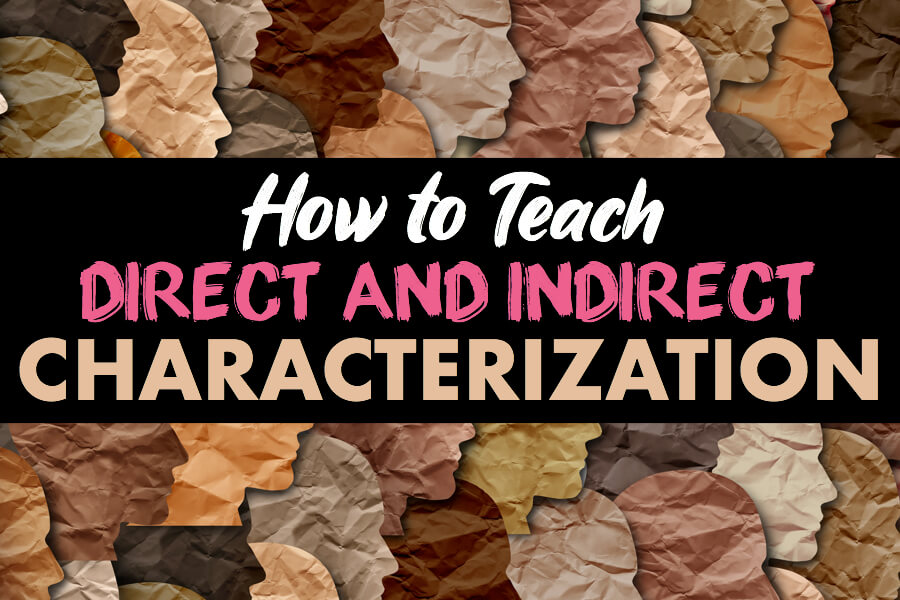
Teaching direct and indirect characterization can be a challenge for teachers and students alike. With the right steps and scaffolding in place, it doesn’t have to be. Let this post be your how-to guide for an effective and engaging learning experience.
We all love a good character, right? As teachers, we can understand and appreciate strong characterization. Surely, our students appreciate good characters too, no? Afterall, great characters are a cornerstone of an engaging story for anyone .
However, our students don’t always come to us with a strong understanding of characterization. Sure, they can identify who the characters are. But can they understand and analyze when and how they are developed throughout a story? Especially when it involves reading between the lines and making inferences ?
Teaching direct and indirect characterization is a must in the ELA classroom. Luckily, this post is the how-to guide you need for successfully teaching direct and indirect characterization.
The Importance of Teaching Characterization
When we teach our students characterization, we are inherently teaching them to be better readers– and writers! By gaining a stronger understanding of who characters are and how they develop throughout a story, students are able to develop a deeper understanding of the story overall. Afterall, without fully understanding a character, students can get caught up in a one-dimensional view of a character, limiting their comprehension (and appreciation) of a multi-dimensional character, as well as a well-developed plot and theme.
A solid grasp of characterization opens the door for analysis of character decisions, motives, and interactions. Therefore, teaching characterization can enhance students’ overall comprehension of the text . It paves the path for a reading experience that goes beyond surface level. And if that isn’t music to your teaching ears…
Defining Direct and Indirect Characterization: Terms to Know (and Teach!)
Before diving into a text, it’s important to ensure students understand the different ways an author reveals characterization. Therefore, be sure to teach students the difference between direct and indirect characterization.
Generally speaking, when it comes to direct characterization, the author does the leg work. Indirect characterization, on the other hand, requires a bit more work from the reader as they read between the lines in order to draw conclusions about the character.
Direct Characterization
Direct characterization refers to when an author directly reveals things about a character. For example, these direct statements could include anything from what a character looks like to what a character feels. As long as the author is explicitly stating it, it’s direct characterization. There’s no inference or deeper digging needed.
- Example: Susie hated the thunder and lightning. It reminded her of how helpless people were in the face of the powerful forces of nature. With each crack and rumble, she sank deeper and deeper into fear.
Indirect Characterization
On the other hand, indirect characterization is all about reading between the lines and drawing conclusions about a character based on what they do, say, and think, as well as how they interact with other characters. Indirect characterization involves making implicit conclusions based on what is said, thought, or happening in a text.
- Example: As Mateo looked around, he realized everyone else was dressed in slacks with button up shirts neatly tucked in. Looking down at his grass-stained jeans and wrinkled graph T-shirt, his cheeks burned as they turned a shade of bright red.
Why stop there? There are other terms to consider when diving into characterization. Therefore, in addition to direct and indirect characterization, you might consider introducing your students to the ideas of foil, round, flat, dynamic, and static characters.
Laying the Foundation for Teaching Direct And Indirect Characterization
Before introducing any literature, plot, characters, or new terminology, simply start with this warm-up. Have students select any person– real or fictional– that they admire. Have them make a list of that person’s personality traits . Then, have them do the same with a villainous character. (To avoid any drama or awkward situations, I ask them to keep this character fictional. Trust me. You don’t want them describing your “mean” co-worker.)
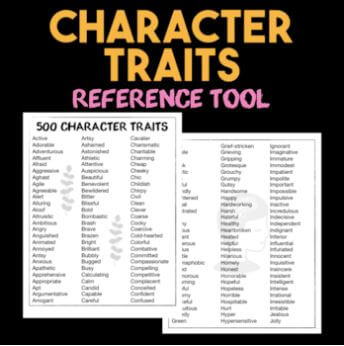
Give them a few minutes to brainstorm each list. Then, have them select ONE trait for each character. Give them a few more minutes for each to explain an example that PROVES that character trait. For example, if they admire their mom because she’s caring, maybe they write about a time when she took care of them when they were home sick, including all of the little things she did for them.
Alternatively, you can write a positive and negative trait on the board and challenge students to explain why/how a person– real or fictional– fits that description. To amp up the stakes, have students duel it out to find the best fit for each trait. Have every student complete the activity before sharing their responses, trying to find the most [INSERT CHARACTER TRAIT HERE] character in the bunch.
Regardless which way you choose to go about the warm-up, you’ll lay the groundwork for teaching direct and indirect characterization. Of course, you can’t call it a day just yet. But with this context, students will be ready to learn all about characterization in literature.
The Challenge with Indirect Characterization
Due to the explicit nature of direct characterization, students don’t need a ton of work with this concept. However, I can’t say the same for indirect characterization. Due to the critical thought and analysis it requires, students need a bit more help understanding and applying the concept of indirect characterization. The following steps can help:
Introducing the Acronym (TSD) or Mnemonic Device (STEAL)
Acronyms and mnemonic devices are a great way to help students remember what to look for when it comes to characterization.
For younger and struggling students, the acronym TSD is a great starting point for indirect characterization. Explain how a lot is revealed about a character by looking at what they THINK, SAY, and DO.
Alternatively, STEAL is a mnemonic device reminding them to look for examples of the following:
- SAYS: What does the character say? How do they say it? What does it reveal about them?
- THINKS: What does the character’s thoughts reveal about them that we might not otherwise know?
- EFFECT: What effect does the character have on others? How do they interact with other characters?
- ACTS: What is the character doing? What do their behaviors reveal about them?
- LOOKS: What conclusions can you draw based on how the character looks ? What does their physical appearance reveal?
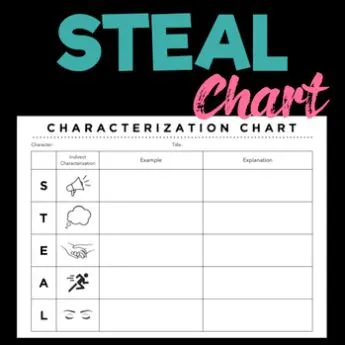
Focus on Finding Evidence
One of our goals as teachers at the secondary level is to encourage students to support their thoughts and conclusions with explicit evidence from the text. At this point, students should be moving on from simply making observations and onto reading between the lines to draw implicit conclusions. Therefore, they must work on explaining their thought process behind their inferences.
When first teaching indirect characterization, consider shifting the focus from character traits to finding evidence. Why? This approach will help students find their evidence first , and then work backwards to determine what the evidence reveals about said character. Otherwise, you risk students mindlessly skimming the pages as they complain they “can’t find any examples.”
So, while many people are used to teaching students to find examples of a certain character trait, consider switching it around and letting students create their own conclusions about a character as they read.
Encourage Success with Scaffolding
Questions, graphic organizers, and thinking stems, oh my!
Those are three of my favorite ways to scaffold characterization, especially when it comes to indirect characterization.
Guide students through characterization by having them answer questions as they read:
- How would you describe [CHARACTER]? Why?
- Why do you think [CHARACTER] acted that way?
- What conclusions can you draw based on their appearance?
- What do you think [CHARACTER] said [INSERT QUOTE]?
- How might the story change if [CHARACTER] was/did [TRAIT/ACTION] instead of [TRAIT/ACTION]?
Additionally, graphic organizers are the perfect scaffolding tool for literary analysis, including characterization. It’s a useful tool in guiding students through a multi-step thought process such as cause and effect. The highly organized and visual nature of graphic organizers helps even those that struggle with comprehension to find success.
Similarly, thinking stems help students get in the right frame of mind to analyze various examples of characterization, such as thoughts, speech, or actions. Scaffolding in this way gives students a frame of reference while still requiring them to do the heavy lifting. Consider the following thinking stems:
- When [CHARACTER] thinks … it reveals …
- When [CHARACTER] says … it reveals …
- When [CHARACTER] does … it reveals …
Advance to Writing Well-Developed Responses
The next step is to translate a graphic organizer or thinking stems into a more thorough response. As you move students from one phase to the next, consider the following steps to writing a well-developed paragraph for character analysis.
Students must first choose an example of indirect characterization, determining which character trait it reveals. Have them begin with one to two sentences summarizing the situation to provide context. Next up? Introduce the telling piece of textual evidence and include the direct quote. Finally, encourage students to expand upon their explanation/analysis of the indirect characterization. How does this example reveal said trait about the character? This might include connecting it back to a main idea, theme, or thesis of the literature or essay.
Have your students do this three times over and BAM! You have the body of a five paragraph character analysis essay.
Assessing Direct and Indirect Characterization
There are a lot of ways you can assess your students’ understanding of direct and indirect characterization. Could you have them write a traditional essay? Sure. But, don’t think that is your only option.
Consider these more creative (and fun) approaches to assessing students’ understanding of these characterization concepts:
- Create a character playlist. What songs would be on there and why? How does each song represent the character?
- Design a character social media profile. I’ve had success with student’s creating Twitter, Instagram, and Facebook profiles for characters.
- Write a character diary. What would the entries be about? How would the character write about certain events and/or relationships?
- Transcribe an interview with the character. What questions would you ask and how would they respond?
- Make a character collage. What elements would you include and why? This is a great way to encourage literal and abstract (direct and indirect) thought.
- Build a character resume. What job would the character apply for? What skills and experience would they include?
Regardless of which activity you choose, the result is the same: A holistic character analysis that includes both direct and indirect characterization!
Teaching Characterization Beyond Character Traits
The beauty of teaching direct and indirect characterization is the ability to expand students’ understanding of what characterization is. Many students stick to the basics of character traits. They could come up with a mile-long list of adjectives describing a particular character.
However, you can use direct and indirect characterization to dig even deeper . To encourage students to consider the why behind those character traits. Challenge students to draw conclusions about character changes, relationships, and motivation. Character tracking is a great way for students to notice characterization over the course of a story.
Ready to get started?
Hopefully you found a few useful tips to bring into your classroom for when you dive into the world of characterization. As for which texts are best to use when teaching direct and indirect characterization, the world of literature is your oyster. You can use excerpts, short stories, or novels. Hey, you can even use video clips, tv shows, and movies if you wish to mix it up! As long as there is good character development, it will work.
Happy teaching, my friend!
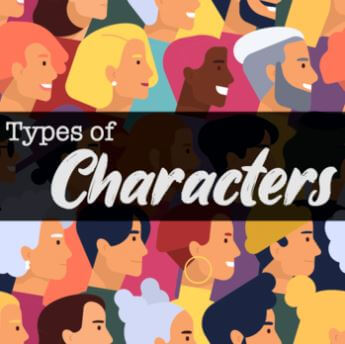
Leave a Reply Cancel reply
Your email address will not be published. Required fields are marked *
Save my name, email, and website in this browser for the next time I comment.
Please log in to save materials. Log in
- Resource Library
- Character Analysis
- Characterization
- Indirect characterization
- Literary Elements
- Short Story
- Story of An Hour
- character-analysis
- characterization
- indirect-characterization
- short-story
- story-of-an-hour
Education Standards
Character analysis- final assessment rubric, characterization assignment.docx, characterization overview presentation (1), https://archive.vcu.edu/english/engweb/webtexts/hour/, https://youtu.be/kwypzvveuky, https://youtu.be/-znd0agqq7i, direct & indirect characterization.

This lesson plan reviews direct and indirect characterizations, which students can use to aid them in writing a character analysis short essay. Students will be introduced to the S.T.E.A.L. method, which they will use to identify a character's traits, motives, and physiological makeup. This resource has been created for secondary levels. This lesson plan can be used to supplement any Literary Element Unit.
NOTES: This activity can also be adapted to a novel that you are reading in class or any short story that has a strong major character.
This lesson will take two class periods to complete.
All materials needed have been provided.
| Students will be able to distinguish between Direct and Indirect Characterization. Students will be able to make educated inferences about a character based on their actions, thoughts, dialogue, and looks. Students will be able to analyze how complex characters develop over the course of a text, interact with other characters, and advance the plot or develop the theme. Students will be able to write a character analysis that is based upon textual evidence and educated inferences based on the character's actions, thoughts, dialogue, and looks. In this lesson, students will learn how characters are developed throughout the plot and are used to progress the overarching theme of the text. Students will learn about direct and indirect characterization in this lesson and will be given the tools and skills needed to analyze and evaluate the major characters within a text. Teachers can use all of the resources attached to this lesson plan to help teach their students about characterization and show them examples to help support and further their understanding of the literary device. Students will use the S.T.E.A.L. model to analyze the main character in the short story, by Kate Chopin, and apply what they have learned from the presentation and examples shown in the lesson. Students then will take the information that they have developed from completing the STEAL chart and apply that evidence and write a character analysis essay that will be the summative assessment of the lesson. Characterization represents a character's traits, motives, and psychology in a narrative. Characterization may occur through the direct description, in which the character's qualities are described by a narrator, another character, or by the character him or herself. It may also occur indirectly, in which the character's qualities are revealed by his or her actions, thoughts, or dialogue. The narrator makes direct statements about a character’s traits. The author tells us about the character’s personality to our face. The author or narrator reveals character traits through actions and speech. Review the presentation on Characterization with your students. Explain the difference between Direct and Indirect Characterization. Review the S.T.E.A.L. method to help students identify character traits through actions and speech. Have students watch the instructional video, Direct and Indirect Characterization "Show and Tell". After the video, have the students verbally explain to a partner what they learned about Direct and Indirect Characterization. Have students watch the instructional video, Characterization Lesson - Examples from Read the short story, The Story of An Hour by Kate Chopin, and have the students high the main character's actions, thoughts, and speech that appear throughout the text. After the class reading, have the students get into small groups and discuss the main character's actions, thoughts, and speech. Have students complete the S.T.E.A.L. graphic organizer. Students will need to identify an example for each category and explain their inference of what insight that gives us to the main character. After the majority of students have completed the graphic organizer, please review it with the class to confirm their understanding of the assignment.
character's traits, motives, and psychological makeup. Students will use the S.T.E.A.L. graphic organizer to write and organize their character analysis. Students' writing will be assessed by the attached rubric.
Have the students create a news report video using Adobe Express. The news report needs to tell the story of the character and include the following information about the character: Overall, the student needs to analyze the character and tell us about them based on what they have learned about them in the story. 1. What does the character say or how do they speak, and what does that tell us about the character? 2. What does the main character reveal in their private thoughts? 3. How do other people in the story view this person? What does that tell us about the character? 4. What does the character's behavior tell us about them? 5. What does the character's appearance tell us about them? What can we infer about them based on what they look like or dress like?
Needs to be 3-5 Minutes in length. Needs to be shareable on Canvas Needs to look professional and be entertaining/interesting Students need to demonstrate their creativity in the video Students need to demonstrate their understanding of Characterization
Thumbnail Image was taken from Free © 2016 |
Version History
Home — Essay Samples — Literature — Metamorphosis — Direct Characterization in The Metamorphosis
Direct Characterization in The Metamorphosis
- Categories: Art History Literature Review Metamorphosis
About this sample

Words: 596 |
Published: Mar 16, 2024
Words: 596 | Page: 1 | 3 min read
Table of contents
The significance of direct characterization, character development and reader engagement, themes and symbolism.

Cite this Essay
Let us write you an essay from scratch
- 450+ experts on 30 subjects ready to help
- Custom essay delivered in as few as 3 hours
Get high-quality help

Verified writer
- Expert in: Arts & Culture Literature

+ 120 experts online
By clicking “Check Writers’ Offers”, you agree to our terms of service and privacy policy . We’ll occasionally send you promo and account related email
No need to pay just yet!
Related Essays
7.5 pages / 3373 words
4 pages / 1745 words
4 pages / 1679 words
2 pages / 1022 words
Remember! This is just a sample.
You can get your custom paper by one of our expert writers.
121 writers online
Still can’t find what you need?
Browse our vast selection of original essay samples, each expertly formatted and styled
Related Essays on Metamorphosis
Franz Kafka's The Metamorphosis is a novella that tells the story of Gregor Samsa, a salesman who wakes up one day to find himself transformed into a giant insect. This critical essay aims to analyze the work by examining themes [...]
Franz Kafka's novella, The Metamorphosis, published in 1915, is a well-known work that explores dramatic actions and transformations, evoking both emotion and expression. It delves into the themes of grief and the stages [...]
Franz Kafka's novella "The Metamorphosis" is a timeless classic that delves into the theme of ambiguity, leaving readers pondering the blurred lines between reality and illusion. As Gregor Samsa wakes up one morning to find [...]
Franz Kafka's "The Metamorphosis" is a seminal work in the canon of existential literature, a genre that interrogates the essence of human existence and the individual's experience of an absurd and indifferent world. The novella [...]
References to food are a recurring theme in Franz Kafka's The Metamorphosis. The food that Gregor eats to strengthen his physical body reflects the attention that he receives from his family to satiate his emotional appetite. As [...]
Have you ever had your physical life changed, but your reality stayed the same? ̈ The Metamorphosis ̈ by Franz Kafka draws on and transforms ̈The Transformation of Arachne Into a Spider ̈, and by doing so, meets the criteria of [...]
Related Topics
By clicking “Send”, you agree to our Terms of service and Privacy statement . We will occasionally send you account related emails.
Where do you want us to send this sample?
By clicking “Continue”, you agree to our terms of service and privacy policy.
Be careful. This essay is not unique
This essay was donated by a student and is likely to have been used and submitted before
Download this Sample
Free samples may contain mistakes and not unique parts
Sorry, we could not paraphrase this essay. Our professional writers can rewrite it and get you a unique paper.
Please check your inbox.
We can write you a custom essay that will follow your exact instructions and meet the deadlines. Let's fix your grades together!
Get Your Personalized Essay in 3 Hours or Less!
We use cookies to personalyze your web-site experience. By continuing we’ll assume you board with our cookie policy .
- Instructions Followed To The Letter
- Deadlines Met At Every Stage
- Unique And Plagiarism Free
Unveiling Characterization in Literature
This essay about characterization in literature explores how authors reveal the essence of their characters through direct and indirect methods. Direct characterization provides clear descriptions, while indirect characterization uses subtle cues like actions and speech. It distinguishes between dynamic characters, who evolve, and static ones, who remain constant. The essay also contrasts round characters, with their complexities, against flat characters, who serve specific narrative roles, highlighting how characterization breathes life into fictional worlds and fosters empathy in readers.
How it works
Characterization in literature is akin to the unveiling of a masterpiece—a delicate dance where authors reveal the essence of their characters through subtle strokes and bold flourishes. It transcends mere description, breathing life into fictional beings and forging connections that resonate deeply with readers.
In the realm of literary craftsmanship, direct characterization serves as the artist’s declaration, boldly outlining a character’s traits and motivations. It’s the author’s brushstroke of choice, painting vivid portraits with phrases that linger in the mind long after the book is closed.
Indirect characterization, however, weaves a more intricate tapestry. It whispers through the character’s actions, the cadence of their speech, and the shadows cast by their choices. It’s the art of subtlety, where a sidelong glance or a fleeting smile speaks volumes about the soul beneath the surface.
Within the narrative landscape, dynamic characters are the catalysts of change, evolving in response to the trials and triumphs of their journey. They breathe with a vitality that mirrors life itself, their growth echoing the universal quest for understanding and self-discovery. Conversely, static characters remain steadfast in their essence, anchoring the narrative with unwavering traits that illuminate the contrasts within the story.
In the gallery of literary personas, round characters emerge as multifaceted gems, their complexities unfolding like petals of a blossoming flower. They embody contradictions, wrestle with inner demons, and evolve through conflict and resolution. In contrast, flat characters serve more utilitarian roles, their purpose defined by the narrative needs rather than the depths of their persona.
At its core, characterization is the alchemy that transforms words into worlds. It’s the magic of empathy, inviting readers to walk in the shoes of protagonists and antagonists alike, to feel their joys and sorrows, and to witness their growth with each turning page.
In conclusion, characterization is the heartbeat of storytelling—a symphony of traits and motivations that shape the human experience within the realms of imagination. Through skillful characterization, authors not only entertain but also enlighten, offering readers a mirror to reflect upon their own journeys and a window into the myriad facets of the human soul.
Cite this page
Unveiling Characterization in Literature. (2024, Jul 21). Retrieved from https://papersowl.com/examples/unveiling-characterization-in-literature/
"Unveiling Characterization in Literature." PapersOwl.com , 21 Jul 2024, https://papersowl.com/examples/unveiling-characterization-in-literature/
PapersOwl.com. (2024). Unveiling Characterization in Literature . [Online]. Available at: https://papersowl.com/examples/unveiling-characterization-in-literature/ [Accessed: 27 Jul. 2024]
"Unveiling Characterization in Literature." PapersOwl.com, Jul 21, 2024. Accessed July 27, 2024. https://papersowl.com/examples/unveiling-characterization-in-literature/
"Unveiling Characterization in Literature," PapersOwl.com , 21-Jul-2024. [Online]. Available: https://papersowl.com/examples/unveiling-characterization-in-literature/. [Accessed: 27-Jul-2024]
PapersOwl.com. (2024). Unveiling Characterization in Literature . [Online]. Available at: https://papersowl.com/examples/unveiling-characterization-in-literature/ [Accessed: 27-Jul-2024]
Don't let plagiarism ruin your grade
Hire a writer to get a unique paper crafted to your needs.

Our writers will help you fix any mistakes and get an A+!
Please check your inbox.
You can order an original essay written according to your instructions.
Trusted by over 1 million students worldwide
1. Tell Us Your Requirements
2. Pick your perfect writer
3. Get Your Paper and Pay
Hi! I'm Amy, your personal assistant!
Don't know where to start? Give me your paper requirements and I connect you to an academic expert.
short deadlines
100% Plagiarism-Free
Certified writers

IMAGES
VIDEO
COMMENTS
Definition of Direct Characterization. Direct characterization means the way an author or another character within the story describes or reveals a character, through the use of descriptive adjectives, epithets, or phrases.In other words, direct characterization happens when a writer reveals traits of a character in a straightforward manner, or through comments made by another character ...
Characterization is an essential part of writing a novel or short story; it helps you understand your characters, and how each character's personality and perspectives can help drive the plot forward. Part of your job as a writer is to learn about your characters by observing how they interact with the world around them. Sometimes, writers ...
8 tips for using direct and indirect characterization. Avoid overusing direct characterization. Be direct with key details. Support direct character statements with scenes. Imply character through action and reaction. Tell direct details that serve concision. Use dialogue to characterize indirectly. Let narrative voice give character.
Direct characterization is defined as an explicit description of a character's traits in a story. Therefore, it is also called explicit characterization. It occurs while introducing the character for the first time in a story is done by the use of descriptive adjectives, phrases, or epithets rather than in an objective manner.
The difference between direct and indirect characterization can be generally summed up by either spectrum of that phrase. In the case of direct characterization, it includes whatever authors expressly tell readers about their characters. Some things need to be directly said because they're important details that readers might otherwise never ...
What Is Direct Characterization? Direct characterization refers to the way a writer explicitly describes a character's traits in the narration of a novel or story, e.g.He had green eyes or She was quick with a joke.. This technique is most often used the first time each character appears on the page, but small amounts of direct characterization can also be used continuously throughout the story.
Characterization is the representation of the traits, motives, and psychology of a character in a narrative. Characterization may occur through direct description, in which the character's qualities are described by a narrator, another character, or by the character him or herself. It may also occur indirectly, in which the character's ...
Direct Characterization. Direct characterization occurs when an author explicitly tells the reader what kind of person a character is. This information can be provided by a narrator or a character ...
Direct Characterization. Narrator explicitly describes a character. To clearly define a character for the reader. Straightforward narratives, introductions. The Great Gatsby by F. Scott Fitzgerald. Indirect Characterization. Traits revealed through actions and dialogue. To allow readers to deduce character traits.
Here is an excellent example of direct characterization from Richard Connell's famous short story, The Most Dangerous Game. In this passage, the story's protagonist, Sanger Rainsford, describes his first encounter with General Zaroff, his antagonist. "Rainsford's first impression was that the man was singularly handsome; his second was that there was an original, almost bizarre quality ...
Defining Characterization Characterization is the process by which the writer reveals the personality of a character. Characterization is revealed through direct characterization and indirect characterization. Direct Characterization tells the audience what the personality of the character is. Example: "The patient boy and quiet girl were both well mannered and did not disobey their
In this essay, we will explore various examples of direct characterization in literature and film, examining how this technique enhances our understanding of characters and contributes to the overall narrative. Through a careful analysis of specific examples, we will demonstrate the importance of direct characterization in creating well-rounded ...
Everyday Examples of Characterization. Online Dating Websites: Every dating websites offer examples of characterization as people pick up certain characters and adopt them as their names. Some even go for avatars. Police Line-ups: Some people adopt different characters of police-line ups to hide their true identities.
January 8, 2024 / 8 minutes of reading. Check out our guide to learn how writing characterization can work to your advantage for creating compelling characters your readers will connect with instantly. Characterization is the process of providing your readers with the information they need to get to know your characters.
Direct characterization occurs when the author specifically reveals traits about the character in a direct, straightforward manner. Direct characterization is also important in showing the ...
An example of direct characterization would be an author explicitly telling the reader that Sally was a teacher who had brown hair, three children, and a favorite hobby. An example of indirect ...
The Impetuous Nature of Romeo. One of the most prominent examples of direct characterization in Romeo and Juliet can be seen in the portrayal of Romeo as impetuous. From the very beginning of the play, Romeo's impulsive nature is established. In Act 1, Scene 1, Benvolio describes Romeo as being deeply infatuated with Rosaline, saying, "Many a ...
Laying the Foundation for Teaching Direct And Indirect Characterization. Before introducing any literature, plot, characters, or new terminology, simply start with this warm-up. Have students select any person- real or fictional- that they admire. Have them make a list of that person's personality traits. Then, have them do the same with ...
STEP #1: Review the presentation on Characterization with your students. Explain the difference between Direct and Indirect Characterization. Review the S.T.E.A.L. method to help students identify character traits through actions and speech. STEP #2: Have students watch the instructional video, Direct and Indirect Characterization "Show and Tell".
Franz Kafka's novella, The Metamorphosis, is a work that delves deep into the complexities of human nature and the human condition. One of the most striking aspects of the novella is Kafka's use of direct characterization, which allows the reader to gain a deeper understanding of the characters and their motivations.
Essay Example: Characterization in literature is akin to the unveiling of a masterpiece—a delicate dance where authors reveal the essence of their characters through subtle strokes and bold flourishes. It transcends mere description, breathing life into fictional beings and forging connections ... Direct characterization provides clear ...
Direct characterization involves an explicit statement which tells the audience about a character's personality or feelings, using the thoughts of other characters. In a novel, the narration could ...
Share Cite. One salient example of direct characterization is found in chapter 5, and it is that of Pap: Huck's chaotic father. Both types of characterizations, direct and indirect, are used for ...